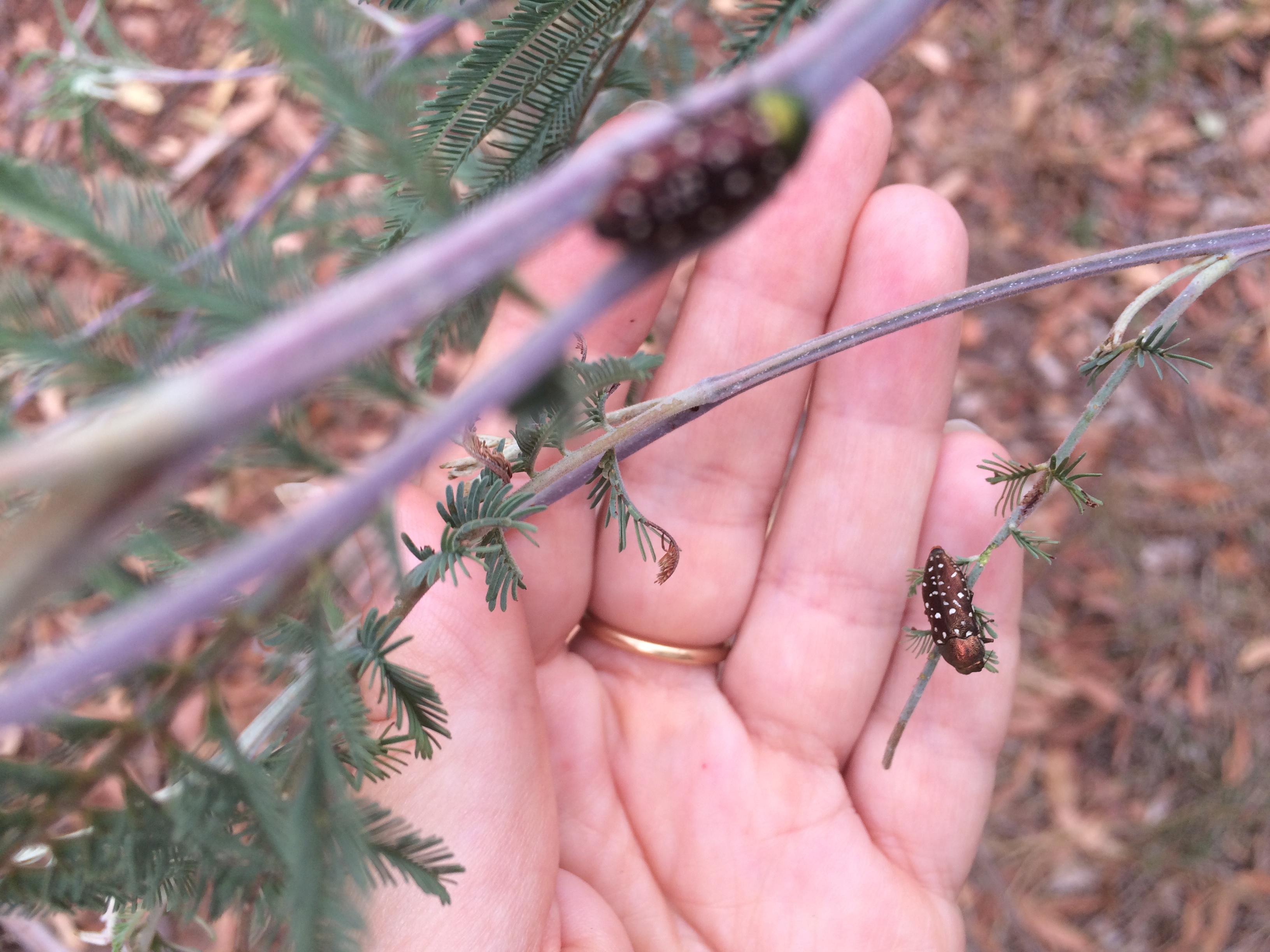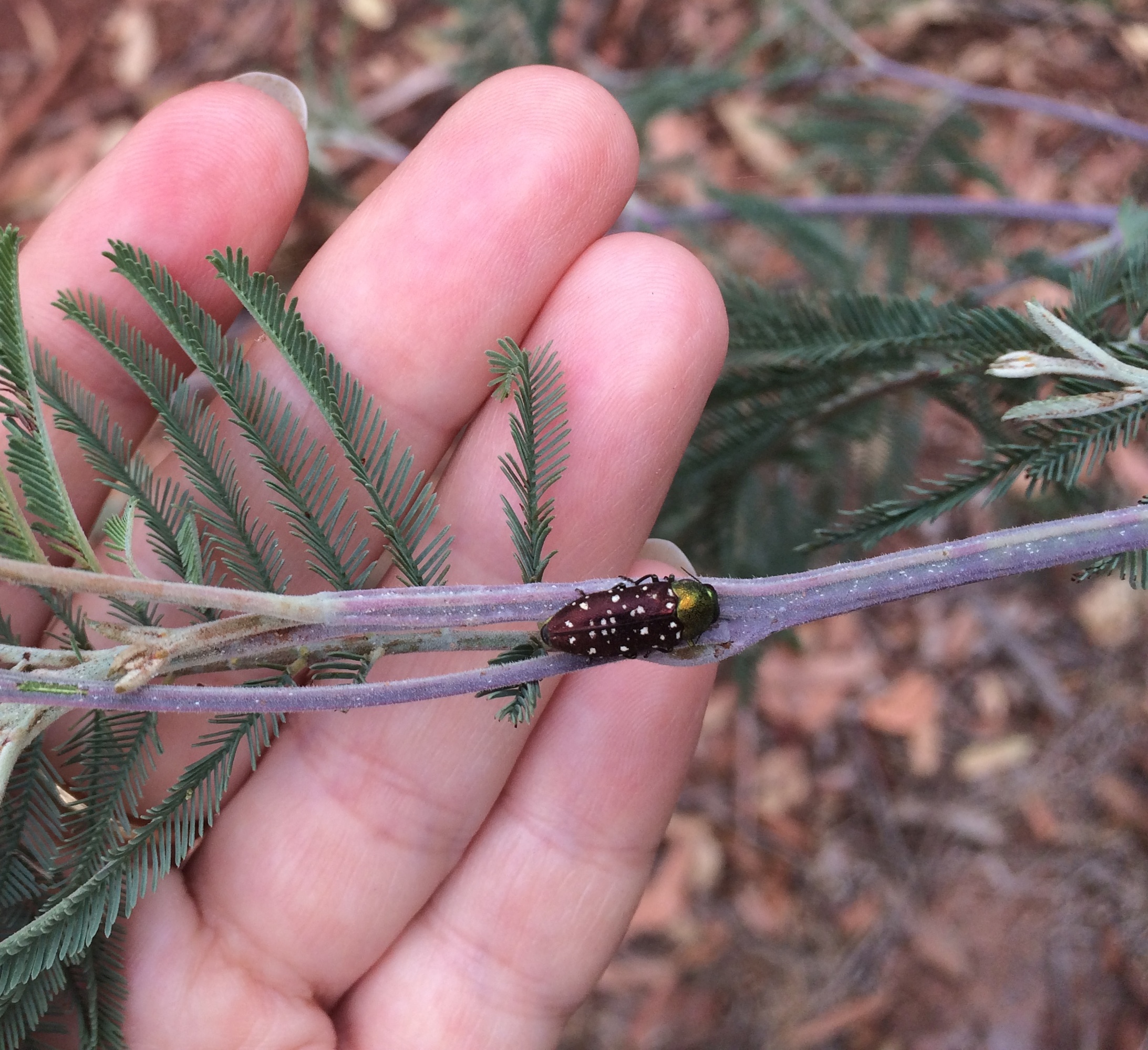What better way to bring in the beginning of 2016 than a beetle-spotting walk?
My dogs are fairly old now, so they do not mind if a slow walk along our dirt road involves the examination of eucalypt and wattle regrowth. One never knows what delights may be observed clinging to the leaves and stems. Insects seem to appear and disappear in stages, so you may get a week or two observing just small golden green beetles, then these disappear and are replaced with treehoppers being attended by ants, or perhaps interesting flies.
On this day however, I was delighted to observe and photograph a couple of my favourite beetles – jewel beetles. Jewel beetles are found worldwide and number approximately 15,000 species. They are much loved for their astounding array of colours, which are often metallic. In Australia, the Buprestidae family has 82 genera and some 1,200 species. Some beetle families vary widely in form, but jewel beetles are very recognisable by their cylindrical, cigar–like body shape, small antennae and very large eyes. Jewel beetles have very cute faces!
The Australian jewel beetle (Julodimorpha bakewelli) is a glossy, golden-brown beetle around 4cm long, found all over Australia in arid and semi-arid areas. This beetle has been featured in the news due to the unfortunate similarity to dumped beer bottles or “stubbies”. The males have been observed trying to mate with the bottles, and the poor fellas will stay there until succumbing to stress and starvation!
Jewel beetles are renowned for being difficult to photograph as they are quite shy and will play dead, dropping off the branch they are on to the forest floor. The pair I saw on the 1st January was most cooperative, staying quite still as I photographed both, using my hand as a focus guide for my iPhone. These two beetles had the same white spots on the back wing cases or elytra, but the thorax was bronze in one and emerald green on the other. A male and female perhaps?
I will be sending these photos to the Melbourne Museum, but from what I have been able to deduce from various beetle and insect websites is that these little guys are found in both NSW and Victoria, and appear to be found on wattle foliage most of the time. They are in the genus Diphucrania.
It is quite hard to get detailed behavioural information on insects – the study of entomology has a major focus on classification and taxonomy, and often centres upon on economically important or pest species. Jewel beetles are a little more well-known than other groups on account of their beauty.
The adults feed on leaf foliage or blossom nectar, and they lay their eggs on an appropriate host plant. The larvae are whitish coloured grub-like creatures that burrow through the stems of wattles and other plants, feeding on the sapwood with their strong jaws. The larval stage may last months or even years. Sometimes, the timber used for furniture still has jewel beetles inside, and the new adults emerge into a house-type situation which is very different from the forest they originated in!
The adults live only for a few days, or up to two weeks. So if you happen to see some jewel beetles in your garden, or on a walk, enjoy their beauty, as they won’t be around in that form for very long…

Beetle with a bronze thorax… This pic also shows their proximity to one another.

And a beetle with an emerald thorax. Lovely!
Hi Tanya,
Great blog. I have a soft spot for Jewel Beetles. I remember in SW Western Australia when I was a boy I found a beer stubby covered in Julodimorpha bakewelli and it was the most confusing sight until I researched them further.
The beautiful Diphucrania species you photographed I think are most likely D. leucosticta. The males have the emerald thorax and the female has copper.
I look forward to reading more of your very interesting blogs,
Craig
Hi Craig! Thanks for your lovely message. I am thrilled you have seen the beer bottle jewel beetles! And lovely to know it is D leucosticta and who is who with the thorax colours. I checked out your blog straight away and I am EVEN MORE THRILLED to see your cherry ballart post – as my next post was going to be some pics of a mass emergence of stink bugs on one of our cherry ballarts – and you have identified them for me – Commius elegans. There were literally hundreds of them, strangely mixed with dozens of honeybrown beetles. So thanks very much! I love how mossy and incredible your cover pic is too – it is terribly dry here in western vic, my eyes could hardly process the green colour. I look forward to reading your blog…
Thanks Tanya. My blog’s cover pic is at the base of Mt Erica. Very lovely spot.